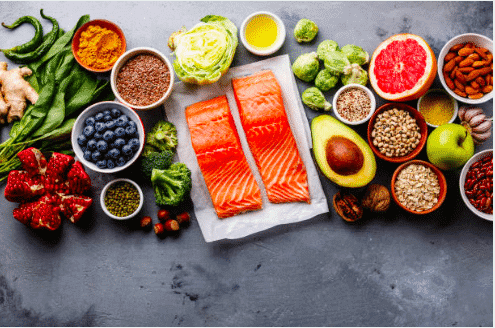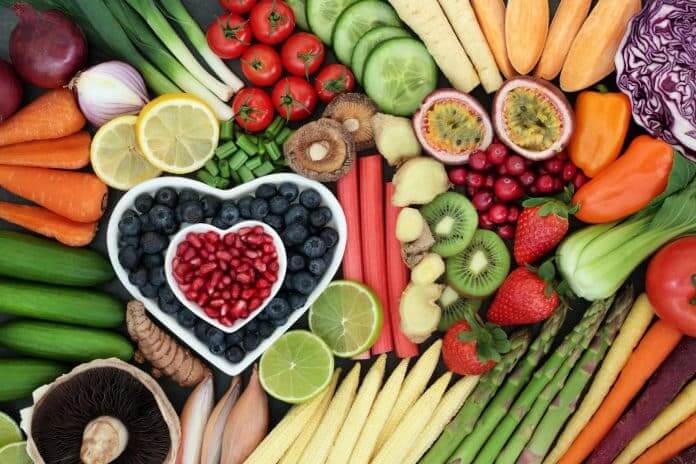
There are certain healthy foods that should be part of every household diet as they contain a wealth of disease-fighting substances. These nutritious items should replace other less healthful foods, helping you to cut calories while boosting the nutrition in your diet.
Berries: Blueberries top the list of antioxidant-rich fruit, followed by cranberries, blackberries, raspberries and strawberries. The colour of berries comes from the pigment anthocyanin, an antioxidant that helps neutralize “free radicals” (cell-damaging molecules) that could lead to chronic diseases, including cancer and heart disease. Berries, particularly cranberries, may also helpful in keeping off urinary tract infections. All berries contain varying but high amounts of vitamin C and potassium, and they’re low in calories and fat. And, unlike some other healthy foods, they taste good too!
Tomatoes: Some studies have shown that tomatoes may be a cancer fighting powerhouse. Tomatoes contain lycopene that helps protect against many cancers. They also have vitamin C, an antioxidant which can prevent cellular damage that leads to cancer. They are rich in vitamin A and potassium. Watermelons, carrots, and red peppers also contain these substances, but in lesser quantities. An increased intake of lycopene has already been linked to a reduced risk of breast, prostate, pancreas and colorectal cancer.
Tea: Tea contains certain antioxidants known as polyphenols (catechins) which appear to prevent cancer cells from dividing. Green tea is best, followed by our more common black tea. Dry green tea leaves, which are about 40% polyphenols by weight, may also reduce the risk of cancer of the stomach, lung, colon, rectum, liver and pancreas.
Spinach: It is hard to beat this green leafy vegetable for vitamins, minerals and antioxidants such as lutein and zeaxanthin. The latter protects against cataracts and macular degeneration, the most common cause of impaired vision. Carotenoids and antioxidants vitamins C and E in spinach are also believed to reduce the risk of cancer, heart disease, stroke and cataracts. And the healthy dose of potassium and calcium found in spinach can help regulate your blood pressure. Spinach and other leafy greens also provide folic acid, which is known to reduce the risk of neural tube defect and heart disease. Spinach leaves can be added to flour to make delicious puris and paranthas.
Broccoli, cauliflower, cabbage, brussels sprouts: These are called the cruciferous family of vegetables. These vegetables have a chemical component called indole-3-carbinol that is shown to combat breast cancer by converting a cancer-promoting estrogen into a more protective variety. Brussels sprouts and cabbage along with other vegetables rich in Vitamins A and C may help against some types of cancer. Carcinogens or substances that are known to cause cancer are ingested and incorporated into the body on a regular basis. Fortunately, the body’s defense system includes specialized proteins that help clear out the different carcinogens before they wreck havoc. Early in the development of prostrate cancer, a group of these protective proteins is knocked out, allowing the damage caused by the carcinogens to spread. Sulforaphane, a compound found in cruciferous vegetables, increases activity of proteins that enable the body to clean up the damage caused by these carcinogens, thereby helping to slow down the cancer growth process.
Soy: Soy products like tofu contain several types of phytoestrogens that could help prevent both breast and prostate cancer by blocking and suppressing cancerous changes. There are a number of isoflavones in soy products, but research has shown that genistein is the most potent inhibitor of the growth and spread of cancerous cells. It appears to lower the risk of breast cancer by inhibiting the growth of epithelial cells and new blood vessels which tumors require to flourish. Soy is currently being scrutinized as a potential anti-cancer drug.

Figs: Figs are reported to be highly effective in helping to shrink tumours. They contain good levels of potassium, calcium, magnesium, iron, copper and manganese. The rich potassium content of figs helps to maintain blood pressure of the body. Figs are rich in dietary fibre which makes them very effective for weight management programmes. Due to their laxative effect, figs are helpful for treating chronic constipation.
Nuts: Nuts are a great source of the healthy monounsaturated and polyunsaturated fats which help lower blood cholesterol levels, particularly when they replace saturated fat in the diet. Macadamias, cashews, almonds, pistachios, peanuts and pecans are rich in monounsaturated fat, while walnuts, hazelnuts, pine nuts and Brazil nuts are rich in polyunsaturated fat. Walnuts are also an excellent source of the polyunsaturated Omega-3 fat, which has benefits for lowering blood pressure and reducing inflammation in the body. Almonds and hazelnuts are the best sources of vitamin E, while peanuts, hazelnuts, cashews, pistachios and walnuts provide useful amounts of folate. Still, nuts pack plenty of calories – and it’s easy to over-eat these tasty treats. So enjoy nuts, but be mindful of your portion size. Try to limit yourself to an ounce a day. That’s about 28 peanuts, 14 walnut halves, or just 7 Brazil nuts.
Avocados: Avocados are rich in glutathione, a powerful antioxidant that attacks free radicals in the body by blocking intestinal absorption of certain fats. They also supply even more potassium than bananas, and are a strong source of beta-carotene. Avocados are a surprisingly complete food, with fourteen minerals to stimulate growth, including iron and copper for your blood.
Dark Chocolates: Studies show that dark chocolates have the highest percentage of cocoa solids that are rich in cell protecting anti-oxidants. Surprised? Most people are. This is because chocolate is a plant-based healthy food and cocoa and chocolate has more antioxidants than blueberries, green tea and red wine. But the bitter truth is that this benefit does not apply to milk or white chocolate, both of which don’t have the same nutritional value as dark chocolate. In addition, the antioxidants in dark chocolate and cocoa may aid bad circulation and unhealthy blood vessels that often pave the way to development of diabetes, while also possibly improving cells’ sensitivity to insulin and glucose. Of course the rules of moderation apply – diet and weight control for people at risk for diabetes is especially important.
READ ALSO: Guilt-free sweetness





